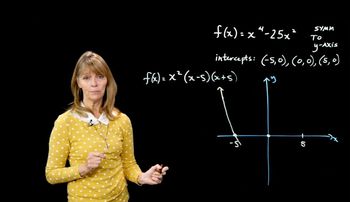Table of contents
- 0. Review of Algebra4h 16m
- 1. Equations & Inequalities3h 18m
- 2. Graphs of Equations43m
- 3. Functions2h 17m
- 4. Polynomial Functions1h 44m
- 5. Rational Functions1h 23m
- 6. Exponential & Logarithmic Functions2h 28m
- 7. Systems of Equations & Matrices4h 6m
- 8. Conic Sections2h 23m
- 9. Sequences, Series, & Induction1h 19m
- 10. Combinatorics & Probability1h 45m
4. Polynomial Functions
Dividing Polynomials
Problem 43
Textbook Question
For each polynomial function, use the remainder theorem to find ƒ(k). ƒ(x) = 2x^5 - 10x^3 - 19x^2 - 50; k=3
 Verified step by step guidance
Verified step by step guidance1
Identify the polynomial function \( f(x) = 2x^5 - 10x^3 - 19x^2 - 50 \) and the value \( k = 3 \).
According to the Remainder Theorem, the remainder of the division of \( f(x) \) by \( x - k \) is \( f(k) \).
Substitute \( k = 3 \) into the polynomial function: \( f(3) = 2(3)^5 - 10(3)^3 - 19(3)^2 - 50 \).
Calculate each term separately: \( 2(3)^5 \), \( -10(3)^3 \), \( -19(3)^2 \), and \( -50 \).
Add the results of the calculations from the previous step to find \( f(3) \).
Recommended similar problem, with video answer:
 Verified Solution
Verified SolutionThis video solution was recommended by our tutors as helpful for the problem above
Video duration:
2mPlay a video:
Was this helpful?
Key Concepts
Here are the essential concepts you must grasp in order to answer the question correctly.
Polynomial Functions
A polynomial function is a mathematical expression involving a sum of powers in one or more variables multiplied by coefficients. The general form of a polynomial in one variable is f(x) = a_n*x^n + a_(n-1)*x^(n-1) + ... + a_1*x + a_0, where n is a non-negative integer and a_n are constants. Understanding the structure of polynomial functions is essential for applying various theorems and methods in algebra.
Recommended video:

Introduction to Polynomial Functions
Remainder Theorem
The Remainder Theorem states that when a polynomial f(x) is divided by (x - k), the remainder of this division is equal to f(k). This theorem simplifies the process of evaluating polynomials at specific points, allowing for quick calculations without performing long division. It is particularly useful for finding function values and analyzing polynomial behavior.
Recommended video:

Higher Powers of i
Evaluation of Functions
Evaluating a function involves substituting a specific value into the function to determine its output. For polynomial functions, this means replacing the variable x with a given number, such as k in this case. Understanding how to evaluate functions is crucial for applying the Remainder Theorem and solving problems related to polynomial functions effectively.
Recommended video:

Evaluating Composed Functions
Related Videos
Related Practice

